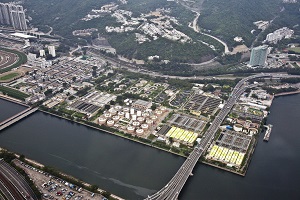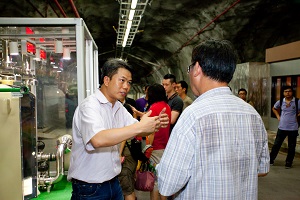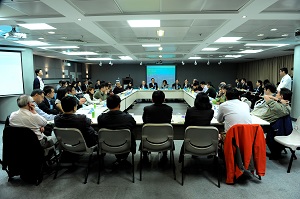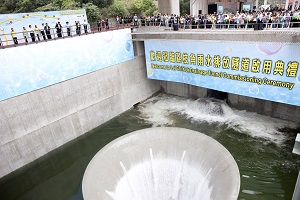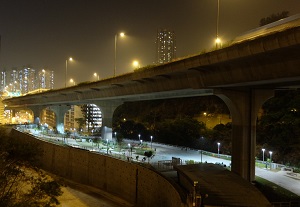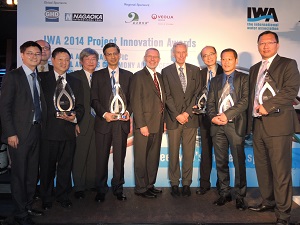Innovative and progressive drainage works
|
Two months ago, I talked about the contribution and experience of the Drainage Services Department (DSD) in sustainable development. Shortly afterwards, I was delighted to learn that at the 2014 International Water Association (IWA) East Asia Regional Project Innovation Awards, the DSD was named the Winner in the “Marketing and Communications” and “Design Projects” categories, and received the Honour Award in the “Small Projects” category. We should be proud of the DSD’s remarkable achievements. The IWA, an international organisation in the water resources sector, established the biennial Project Innovation Awards to recognise outstanding and innovative water engineering projects around the world. The DSD’s winning projects cover the department’s two main areas of work, i.e. flood prevention and sewage treatment, as well as various work stages such as planning, design, construction and operation. It shows that the DSD has been striving for the best in each and every stage of works management and has earned international recognition. Let us have a look at the DSD’s three award-winning projects.
“Marketing and Communications” category award – deliberation with stakeholders The DSD is responsible for the relocation of the Sha Tin Sewage Treatment Works (Sha Tin STW) to caverns, a major project that has attracted much attention. During the planning stage, the DSD invited stakeholders to participate in the public engagement activities for joint deliberation on the issue. As the community is unfamiliar with the concept of sewage treatment works in caverns, the DSD took a brand-new “Experiential, Multi-platform and Iconic” approach in carrying out the public engagement activities, so that the public would have an in-depth understanding of the relocation project and be able to fully express their views. First, the DSD invited members of the public and stakeholders to visit the Stanley Sewage Treatment Works, the first such facilities located in caverns in Hong Kong, where they could feel and experience for themselves the environment inside and outside the caverns, as well as the effect of a mini-deodorization equipment specially designed by the department. In addition to the conventional communication channels such as public forums, community group meetings, focus group meetings, roving exhibitions, as well as information dissemination through websites, newsletters, promotional videos and the 24-hour hotlines, the DSD also created an iconic cartoon ambassador, “Dr Marmot”, and produced short and easy-to-understand animations to explain to the public the relocation project and detailed operation of the sewage treatment works in caverns. With such initiatives, the community can be kept posted of the latest development of the relocation plan. This innovative public engagement activity has enhanced public understanding of sewage treatment works in caverns and succeeded in engaging the stakeholders so as to help us launch and improve the works.
Honour Award in “Small Projects” category – innovative technology in sludge treatment The innovative technology of “co-settling” sets a new direction for the workflow design of sewage treatment. With this technology, the DSD won the championship in the Technology Category of the Innovation Award for the Engineering Industry 2012/2013 presented by the Hong Kong Institution of Engineers, and received the Merit Award in the 2012 Hong Kong Awards for Environmental Excellence – Green Innovations Awards.
Winner in the “Design Projects” category – intercepting stormwater in the uphill catchment area to relieve flooding The DSD has adopted an innovative method of intercepting stormwater in the uphill catchment area and discharging it directly into the sea, hence bypassing the downstream urban areas and alleviating the risk of flooding in northwest Kowloon. Compared with the conventional approach of carrying out improvement works for the existing underground stormwater drainage system in the busy urban areas, the stormwater interception works were carried out only on the urban fringes and this design has minimised disruption to the community during construction. The DSD has exemplified the spirit of innovation and continuous improvement not only in the concept of the project but also in its design and construction processes. During construction, our colleagues used a specially designed Tunnel Boring Machine (TBM) to carry out drilling works in two markedly different ground conditions. Compared with the conventional approach of using two different TBMs, the new method has resulted in significant savings of cost and social resources. In addition, to complete a tunnel section of 45 metres deep in soft ground, the DSD applied the air compression procedure with hyperbaric pressure of up to 4.2 bars for the first time in Hong Kong. With a remarkable safety record of zero cases of “decompression illness” involving workers, the project has paved the way for large-scale high pressure tunnel works in future. As I mentioned before in My Blog, the DSD has seized every opportunity to implement the idea of sustainable development in its works. Take the Lai Chi Kok Drainage Tunnel as a good example, which was constructed under the viaduct of the Tsing Sha Highway with the service yard above the stilling basin of the tunnel transformed into the largest pet garden in Kowloon. The rainwater collected is treated and used for gardening, toilet flushing and cleaning the garden, as well as street cleaning by the Food and Environmental Hygiene Department. Since its establishment in 1989, the DSD has endeavoured to provide quality services in flood prevention and sewage treatment for the community. Facing the challenges of urban development, the DSD has adopted an innovative approach in the implementation of works projects, and has striven for continuous improvement to enhance the operational efficiency of drainage facilities. I trust that the department will keep up its efforts in serving the community from the heart and promoting the sustainable development of Hong Kong.
|
|
8 June, 2014
Back